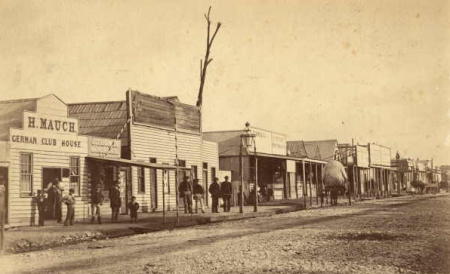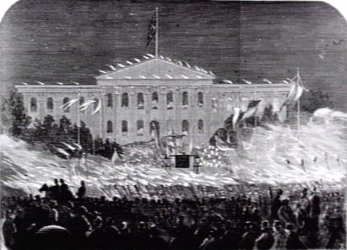![]()
Germans on Victoria's Gold Fields
| Intro 1 | Intro 2 | Bendigo | Ballerstedt | Frederick Vern |
German Associations
The gold rushes brought many German-speaking people to Victoria, but their arrival didn't result in any new closed German-speaking settlements because it was natural for gold-seekers to move around a lot, and when they finally settled down, if they didn't leave Victoria, they usually had non-German-speaking farmers around them. Nevertheless, as mentioned below, there were so many Germans in some of these towns that they formed clubs and built Lutheran churches etc.
By 1864 there were about 13 German Associations (Vereine) amongst Victoria's gold field towns. These were mainly towns around which German ex-diggers had settled when the land acts of the early 1860s allowed people to select land for small farms. In his article "The Deutsche Vereine of Victoria in the Nineteenth Century" Tom Darragh has described regional Vereine in the following towns and villages: Ballarat, Maryborough, Avoca, Creswick, Taradale, Beechworth, Castlemaine, Talbot, Smythes Creek (south of Ballarat), Majorca, McCallums Creek, Bendigo, Middle Creek (or Baranduda, near Yackandandah), and Tarrangower (Maldon). Maldon also had a Turnverein or gymnastic club, which appears to have been the first Turnverein established in Victoria. Friedrich Courtin, founder of the Maldon Verein, was Victoria's first mayor of German origin when he became Mayor of Maldon in 1860. Maldon was the only country Verein to have its own building (September 1857); other country Vereine usually met in a reserved room in a hotel owned by a German.

H. Mauch German Club House, Majorca, 1866
(La Trobe Picture Collection, State Library of Victoria)
The Ballarat Deutscher Verein had its library at the Dutch Harry Hotel; it consisted of nearly 2000 books. Some Vereine established a Krankenkasse (sickness benefits fund) for their members. Some of the regional Vereine lasted only a short time, while the Ballarat and Bendigo Vereine continued past the year 1900.
Theodor Müller was an active member of Victoria's German Associations, both in the country and in Melbourne. He wrote many poems in German and was considered Victoria's German poet.
|
Evidence of the geographic distribution of German-speakers in Victoria in the 19th century is the fact that the 26 Victorian agents for the newspaper "Australische Deutsche Zeitung" in 1870 almost all lived in rural towns. In 1867 the German associations of Victoria held a torchlight procession in honour of the visiting Duke of Edinburgh (who was half-German; his father was Queen Victoria's husband, Albert of Saxe-Coburg and Gotha). There were 1000 torches and three choirs, German shops were decorated and some displayed the German flag. The welcoming committee (which included the artist Eugène von Guérard) pledged the German colonists' loyalty to the Queen and England and hoped for continued friendship "between the two Teutonic nations, England and Germany." |

"Visit of H.R.H. the Duke of Edinburgh.
The German torchlight procession in front of Public Library."
Wood engraving, Robert Stewart 1867
La Trobe Picture Collection, State Library of Victoria
(Copy of Tom Darragh's article "The Deutsche Vereine of Victoria in the Nineteenth Century" available from D. Nutting.)
| Top | Back
| Chronology | Issues
| Students | Site Map |
auf Deutsch |
| Primary Sources (in German) | Bibliography
| Search |
German Australia © D. Nutting 2001